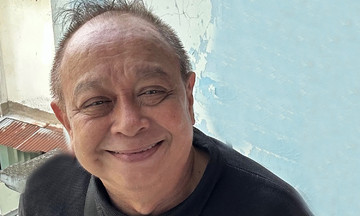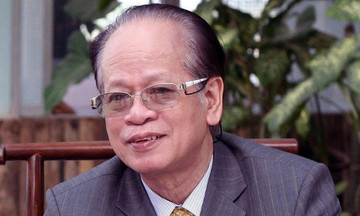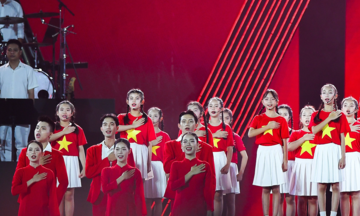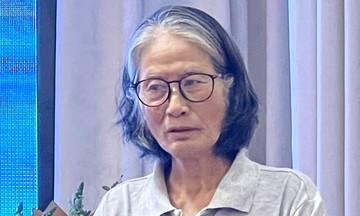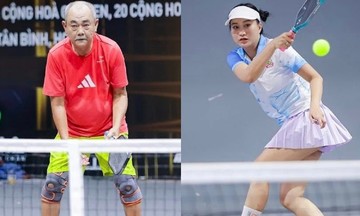* This article reveals some of the film's plot.
Scripted by author Chu Lai, the film is set in 1972, when the People's Army of Vietnam (PAVN) had taken control of Quang Tri province, the dividing line between North and South Vietnam. Having lost this strategic base and facing the potential loss of Thua Thien province, the US reinforced the Army of the Republic of Vietnam (ARVN) to recapture Quang Tri, especially the ancient citadel, as leverage for a favorable peace agreement. The script follows the 81-day battle to defend the citadel, intensifying as it progresses.
Using contrasting imagery, the director highlights the disparity between the PAVN and the US-backed ARVN. Flycam shots show the enemy's advanced weaponry, from B-52 carpet bombing and precision-guided munitions to artillery barrages, devastating the citadel. Meanwhile, the PAVN, with limited resources and cut off from supplies, faces a brutal reality where human resilience shines through.
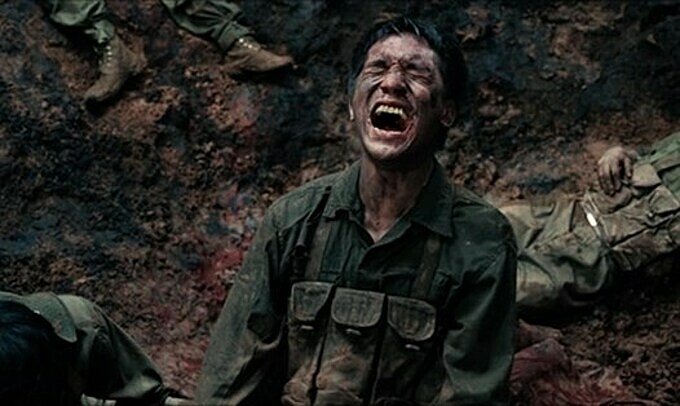 |
A scene from the film "Red Rain". Photo: Provided by the film crew |
Squad 1 consists of idealistic young soldiers, most of whom are experiencing combat for the first time. The central character, Cuong (played by Do Nhat Hoang), is a charismatic martial artist and music student who abandoned a study abroad opportunity to enlist. During the Quang Tri campaign, Cuong fights alongside Squad Leader Ta, a blunt and forthright man; Binh, an art student; Tu, a high school student who wrote his enlistment application in blood; Hai, an expert in electrical and plumbing systems; and Sen, a seasoned special forces soldier.
Hailing from diverse backgrounds with varied personalities, they are united by their shared goal of fighting for peace. Ta, though rough around the edges, cares deeply for his men. Cuong and Binh embody the romanticism of young intellectuals. Hai and Sen are quiet and hardworking, while Tu possesses the innocence of youth. Throughout the life-or-death battles, the squad members support and protect one another.
The film captures the essence of military life during rare moments of peace amidst the war. Soldiers tease each other about family, love, and even death. Ta confides in his comrades about missing his wife and children, writing letters to them. Cuong and Binh compose music and create art, while Tu cares for a small bird that has fallen into their bunker. Even when the bunker floods and they suffer from scabies, Ta remains optimistic, focusing on fighting the enemy to forget their hunger and itching.
The film evokes strong emotions as Squad 1 dwindles after each battle. The director unflinchingly portrays soldiers buried in the earth, their bodies fragmented. The river crossing scene is particularly moving, showing soldiers dying from artillery fire just after reaching the other side, crying out for their mothers.
While heroic, the characters remain relatable, displaying their human vulnerabilities. Halfway through the campaign, facing numerous casualties and harsh conditions, their spirits waver, but they quickly rally each other. Tan, a new recruit who survives the river crossing, is immediately confronted with more bombing and gunfire, shaking him deeply. Ta shows a moment of weakness when he sees an enemy soldier clutching a photo of his family, preventing him from attacking. When called upon for the final battle, Cuong hesitates, thinking of his waiting sweetheart, but ultimately chooses to stand with his comrades.
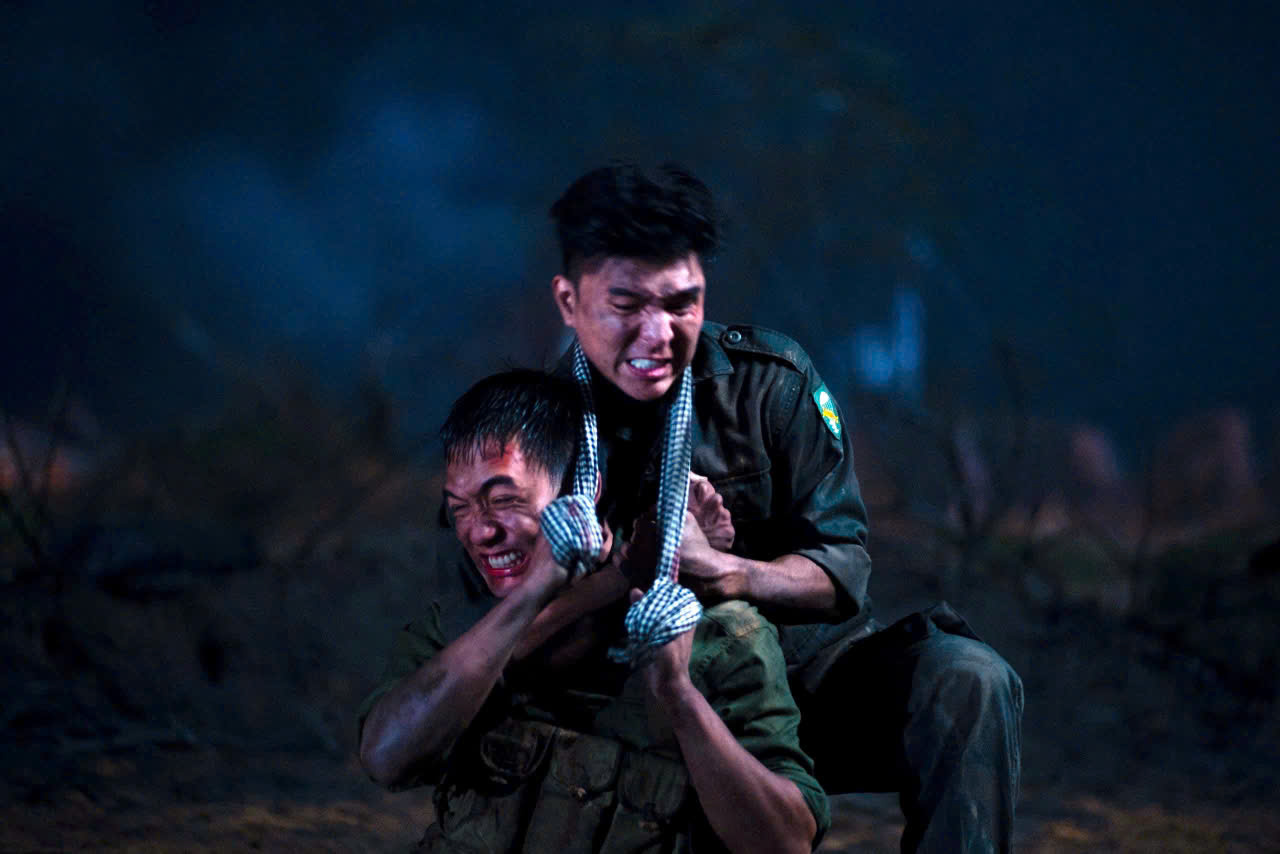 |
Cuong (Do Nhat Hoang, left) and Quang (Steven Nguyen) in a hand-to-hand combat scene towards the end of the film. Photo: Provided by the film crew |
The film also offers a humane perspective on the ARVN soldiers, portraying them as fathers, husbands, and sons with families waiting for their return. Quang (played by Steven Nguyen) is heartbroken by the civilian casualties and the sight of orphaned children. He shares a poignant farewell with his mother before returning to battle.
Romantic elements are woven through Cuong's relationship with nurse Hong. The scarf she gives him becomes a symbol of their love, which he cherishes. During his fight with Quang, the scarf becomes Cuong's weapon.
While lacking big-name stars, the cast delivers strong performances. Do Nhat Hoang (Cuong), Steven Nguyen (Quang), and Phuong Nam (Ta) bring their characters to life. Chosen from over 1,000 candidates through auditions in Hanoi and Ho Chi Minh City, they underwent rigorous training in military conduct, martial arts, and combat skills before filming.
"Red Rain" impresses with its meticulously crafted 50-hectare film set. Large-scale battle scenes appear authentic, resembling documentary footage. Explosions were overseen by Thai experts and the Vietnamese Engineering Corps. Authentic military vehicles and weaponry were used. The film's visuals are stunning, even in night scenes. Horizontal shots parallel to the water's surface emphasize the danger faced by soldiers swimming and paddling across the river.
Beyond the battlefield, the film meticulously recreates other locations like the field hospital and strategy meeting rooms. Hundreds of extras portrayed wounded soldiers crowding the operating room. The art director incorporated details like tree roots growing through the bunker walls and moss covering the damp surfaces. Props like beds, stretchers, and medical supplies appear worn and rudimentary. The film crew even used real maggots in some wound dressings.
Director Dang Thai Huyen stated the crew put 200% effort into the film. During the three-month shoot last year, they faced adverse weather conditions, including cold rain and flooding.
Director Bui Thac Chuyen believes "Red Rain" was more complex than his film "The Underground," due to the scale and difficulty of filming ground-based battles: "The filmmakers had to balance realism with novelty, keeping the audience engaged and wondering what would happen next."
 |
Cuong (Do Nhat Hoang) with nurse Hong (Ha Anh). Photo: Provided by the film crew |
Audience member Nguyen Van Tho, a writer, remarked, "For two hours, the audience was captivated by the elaborate war sequences. It's been a long time since I've seen such an excellent Vietnamese war film. As a veteran of two northern and four southern campaigns, I was deeply moved by the film's realistic portrayal of war, unflinchingly depicting the pain and loss."
Nguyen Van Hoi, 77, head of the K3-Tam Dao Battalion liaison committee and a Quang Tri veteran, said, "Red Rain brought back those 81 days and nights. My comrades who fell at the citadel must be smiling down on us. Those of us who were there couldn't hold back our tears while watching the film."
However, the film has some shortcomings. The love triangle between Cuong, Quang, and Hong feels underdeveloped and unconvincing. Some dialogue is stiff and propagandistic. The female diplomat in the negotiation scenes lacks the necessary authority and sharpness.
"Red Rain" has garnered significant attention, earning 40 billion VND on its opening day, 22/8, exceeding "The Underground's" opening day revenue by 10 billion VND. Many predict the film will soon surpass 100 billion VND due to its quality and timely release during the August Revolution and National Day (2/9) holidays.
Ha Thu




